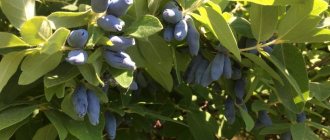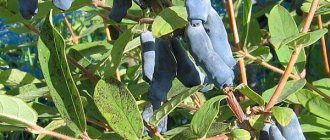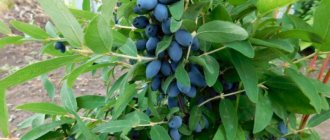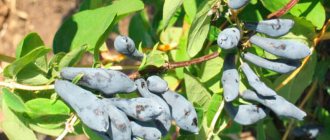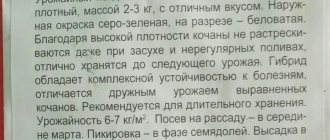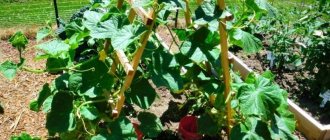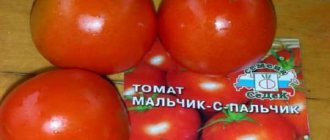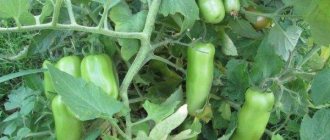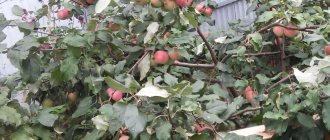History of the variety's creation
This variety of honeysuckle was bred by plant breeders from the Siberian Research Institute of Horticulture named after. M. A. Lisavenko. The original authors are considered to be scientists Z. P. Zholobova, I. P. Kalinina, Z. I. Luchnik. The Kamchatka honeysuckle variety Start was taken as a basis; when developing a new variety, open pollination of seedlings was used.
Photo of honeysuckle Blue spindle
The variety was developed in the last quarter of the last century, and tests of the Blue Spindle honeysuckle were carried out on state varietal plots located in Siberia since 1980 and lasted 9 years. And then in 1989 this honeysuckle was included in the State Register of Russia.
Blue spindle is recommended for cultivation in almost all Russian regions.
Brief overview of Blue Spindle honeysuckle - video
Selection of planting material
For planting honeysuckle, it is best to use 2-year-old seedlings. They should be purchased from special nurseries that have documentation describing the variety. Or make planting material yourself using an existing bush. Otherwise, there is a risk of growing not a Blue Bird, but a completely different plant
It is important to remember that there are a lot of varieties of honeysuckle and among them there are a sufficient number of unedible species
When purchasing a seedling, it must meet the following parameters:
- height – 30-50 cm;
- age – 2-2.5 years;
- well-developed closed root system;
- no visible defects.
Preference should be given to seedlings grown in the region where it will be planted. Don't bring it from afar. At the same time, it will be better adapted to local conditions and will tolerate transplantation into the ground for a “permanent place of residence.”
Honeysuckle Blue Spindle: characteristics and description of the variety
The bushes of this honeysuckle are compact and not too tall - their shoots can reach 0.8-1.0 m in height, and the crown is round in shape with an average number of branches.
Photo of a bush with honeysuckle Blue spindle
The skeletal shoots of the bush are located at an acute angle to the soil surface. The branches themselves are thin and without pubescence. Their color is deep emerald, but under sunlight it can change to anthracite.
The foliage is large, elongated oval, rich emerald in color. The leaf blades are sharp at the base and ends, and have a clearly defined vein in the middle.
Photo of the appearance of honeysuckle foliage Blue spindle
On a note!
One of the characteristics of Blue Spindle honeysuckle is the peeling of bark on the shoots as it ages.
The sizes of ripe Blue Spindle honeysuckle berries remain the same regardless of the growing region - their weight is about 1.2-1.3 g, up to 3 cm long and about 1 cm in diameter.
Photo of the size of ripe honeysuckle berries Blue Spindle
And the very shape of the ripe fruit is similar to a long spindle (hence the name of this honeysuckle).
Ripe berries are blue-blue in color with a characteristic waxy coating, a flat base and compacted skin. On the surface of the skin, tubercles located across the berries are clearly visible.
The taste of the berries is sweet and sour, delicate. During periods of drought, the fruits may become bitter. At the same time, the taste qualities of the harvested crop directly depend on the regions where the variety is grown.
Interesting!
The tasting assessment of the taste of Blue Spindle honeysuckle can therefore range from 3.6 to 4.2 points. But in its revised form, this score is already higher – up to 5 points.
The harvested crop tolerates transportation well over any distance without losing its presentation and taste, and has good shelf life.
Honeysuckle Blue spindle is an early ripening variety,
therefore, the harvest of ripe berries begins in the second decade of June.
Main characteristics
Edible Bluebird Honeysuckle is a deciduous, woody perennial shrub with straight, vertical shoots. He can live up to 30 years. It is quite tall in size. When developed under the most favorable conditions, its shoots can reach 2 m in length. On average, the size of the shrub is about 1.4-1.7 m in height.
Bluebird foliage is elongated, ovoid, and bright green. They grow on thin long shoots. New branches are pale green in color, and later darken, becoming red-brown. The foliage on the shoots forms a very thick and dense crown, which over time acquires a rounded shape. The diameter of the bush varies between 1.5-1.7 m. In the first few years, no particular growth of shoots is observed, however, after 3-4 years the bush begins to grow rapidly.
The shrub blooms in early spring, in mid-late March, immediately after the start of the thaw. The flowers are yellow-brown. They grow in small inflorescences and are bell-shaped. The ovaries can withstand periodic frosts down to -5...-8 C, which is explained by their natural high frost resistance. The flowers have a pleasant aroma and are excellent honey plants.
The shrub begins to bear fruit in the 3rd year after transplanting into the ground. The fruits ripen by early summer and are one of the first berries of the new season. They grow up to 2 cm in length (average sizes are 1-1.2 cm) and weigh 0.8-1.5 g. The yield from one bush is up to 2-3 kg, but only after the bush has reached its maximum bear fruit (that is, at the age of 7-9 years).
The fruits are covered with a delicate dark blue skin with a waxy coating that is easily washed off. In shape they resemble a deformed ellipse, expanded in the middle. The berries are very tasty. Professional tasters rated their taste at 4.5 points on a five-point scale. The fruits are tender, pleasantly tart, have a pronounced sweet taste with a slight sourness, a little reminiscent of blueberries. Unlike other varieties, Bluebird berries are sweeter due to their high level of sugars.
The fruits are extremely healthy - they contain large amounts of vitamin C and other microelements important for the body. However, their main drawback is rapid crumbling. Therefore, they must be collected immediately after ripening or placed under the bush with cane or fiber.
Pollinator shrubs for the Blue Spindle honeysuckle variety
This honeysuckle variety is a self-fertile plant.
The pollen of the plant itself does not pollinate the flowers, so fruits cannot be set.
As a result, if other varieties of honeysuckle with similar flowering periods are not planted nearby, then the yield of Blue Spindle will be no more than 10% of normal.
The best pollinating varieties for honeysuckle Blue Spindle:
- Cinderella;
- Blue bird;
- Azure;
- Kamchadalka;
- Tomsk
DECORATIVE HONEYSUCKLE!
Honeysuckle Honeysuckle
Need to know!
The best productivity of the Blue Spindle is observed if at least 3-4 other varieties of honeysuckle grow nearby.
Honeysuckle Blue Spindle is frost-resistant.
It is highly resistant to long periods of drought and severe frosts,
withstands frosts down to -45 degrees Celsius and does not require shelter.
Breeding honeysuckle
This is a varietal representative, so the generative method of propagation is not suitable. In this case, there is no way to preserve the characteristics of the parent instance. In addition, seedlings obtained from seeds are very weak. They enter the fruiting phase late and may even die.
The most common method is cuttings. Cuttings are prepared from annual shoots
They are plucked from the heel of the parent specimen in June and rooted in the greenhouse. The latter is mandatory because it allows you to achieve a high level of humidity. Without it, successful rooting is impossible. High humidity will have to be maintained throughout the season. To speed up the root formation process, it is better to treat the planting material with a growth stimulant.
Honeysuckle "Blue Spindle" is an unpretentious shrub. Which requires a minimum of attention from the gardener. And in exchange, it gives a lot of tasty and healthy fruits, rich in vitamins.
Productivity of the Blue Spindle variety
The Blue Spindle honeysuckle variety begins to bear fruit 4-5 seasons after the seedlings are planted in a permanent place.
The berries begin to ripen around the 13th-20th of June (depending on the region in which the plant is grown). The fruits ripen unevenly, so the harvest stretches for 10-12 days, sometimes for a longer period.
Photo of honeysuckle harvest Blue spindle
The yield of the Blue Spindle honeysuckle variety is stable and abundant regardless of the region of cultivation and amounts to 1.9-2.1 kg per bush.
Important!
Ripe berries do not adhere well to the petioles and are prone to shedding, so if you do not collect ripe fruits on time, you can lose up to 1/5 of the harvest.
Trimming and shaping
Forming the Blue Spindle is easy. Firstly, the bush of this variety is not too dense, and secondly, any honeysuckle does not like pruning. Berries are formed on annual, not yet lignified growths. If you shorten the branches, you will deprive yourself of the harvest. Therefore, the formation consists of only two stages:
- For the first 3 years after planting, the bush should grow as it wants.
- Then annually cut out 2-3 of the oldest branches near the ground into a stump or shorten them to a strong vertical shoot.
Old branches differ from young ones: they are thicker, coarser, their bark has a dark tint, but the main feature is that weak (short) growths grow on such branches, or there are none at all.
Many people mistake cracked and hanging bark in ribbons as a sign of aging or disease. However, this is a biological feature of honeysuckle; it also appears on young branches.
Rejuvenating honeysuckle pruning: old branches are shortened to strong vertical growths
Simplicity of formation does not negate annual sanitary pruning and thinning. Every spring, trim off all the branches growing inside the crown and down to the ground. If the branches cross, interfere with each other, or shade, cut out the most clumsy one that spoils the appearance of the bush. It must be removed in parts, that is, by cutting it into pieces. If you pull crooked branches entirely from the bush, you will damage the rest. When pruning, try to give the bush a beautiful appearance, that is, leave the shoots equidistant from each other, directed in different directions and upward. Cut back those growing low along the ground. Such branches are good for propagation by horizontal layering, but they usually do not bear berries.
Advantages and disadvantages
According to the description of the Blue Spindle honeysuckle variety, its main advantages are:
- early berry ripening;
- the yield remains high regardless of the climatic conditions in which this honeysuckle is grown;
- the fruits of the Blue Spindle are large and tasty;
- the bushes are compact and unpretentious in care;
- the variety is highly resistant to frost, can withstand cold temperatures down to – 45 degrees Celsius, and therefore does not require shelter before the onset of winter;
- Fruits on this berry perennial can set even at negative air temperatures (up to – 7 degrees Celsius);
- Honeysuckle Blue Spindle has high immunity, so it does not suffer from diseases and is not affected by insect pests.
EXCELLENT VARIETIES OF BLACKBERRY!
Blackberry Black satin Black satin Blackberry Agawam Blackberry Natchez
There are practically no disadvantages to this honeysuckle, but you need to know:
- during periods of drought, bitterness appears in the taste of ripe fruits;
- ripe fruits are prone to shedding, which leads to loss of approximately 1/5 of the harvest.
Diseases and pests
Many gardeners note the high resistance to diseases and pests of the Blue Spindle variety. But, there are some pests that can attack bushes.
Sometimes cracked and drooping bark is mistaken for a manifestation of the disease, but this is the biological structure of the honeysuckle bark.
Common diseases:
- Cladosporiosis or brown spot. The fungal disease appears on the leaves of the lower tier, then covers the entire plant. Brown spots appear on the upper side of the leaf, between the veins. A gray velvety coating forms on the underside of the spots.
- Megaloseptoria or blackening of branches. The fungus develops in conditions of high humidity. As the buds develop, they turn black and die.
- Powdery mildew. Fungal infection. It manifests itself in the formation of whitish-gray spots in the form of a coating; over time, liquid appears on them, resembling dew drops.
- Tubercularosis. The disease is of fungal origin. The first manifestations can be detected on the inside of the leaf in the form of red lumpy spots. Then the branches of the bush are affected.
You can overcome diseases with the help of a 3-4% solution of Bordeaux mixture or the drug Skor.
Honeysuckle berries are loved by honeysuckle fingerwing caterpillars. You can fight the pest with the help of drugs:
- Confidor;
- Inta-vir;
- Decis;
- Actellicom.
Preventive treatments against pests and diseases are not carried out.
Honeysuckle Blue spindle: planting a shrub
Planting and subsequently growing honeysuckle of the Blue Spindle variety is very simple; the main thing is to follow some rules, which even novice gardeners can cope with.
Photos of honeysuckle seedlings Blue spindle
It is better to plant two-year-old seedlings of this honeysuckle variety on your site, which are best purchased in nurseries.
Criteria for selecting planting material:
- sufficiently developed root system;
- shoot size – their height should be more than 26 cm;
- bushes with weak broken shoots should not be taken;
- There is also no need to buy tall (more than 1.5 m) plants - they will take a long time to acclimatize, and fruiting will not occur immediately.
Photo of planting honeysuckle Blue spindle
When purchasing planting material with an open root system, it is better to plan its planting in a prepared place in the autumn; the approximate time for planting Blue Spindle honeysuckle is a month before the expected start of frost.
Even young bushes are resistant to cold, so they will overwinter well. And when planting plants in the spring, they will actively increase the vegetative mass during the summer to the detriment of the development of the root system, and as a result, such bushes will be sick for a long time and may die.
On a note!
But purchased planting material in containers with a closed root system can be planted at any time of the year (except winter, of course).
DECORATIVE BARBERRY!
Barberry Thunberg Rose Glow
Honeysuckle Blue spindle grows in one area for at least 20 years,
therefore, before planting it, you should choose the right place.
It must meet the following requirements:
- be well lit by sunlight;
- protected from gusts of cold winds and drafts;
- on the site, groundwater should not approach the surface of the earth closer than 1.0-1.3 m.
The size of the planting hole must be at least 0.4 * 0.4 m. But its specific size depends on the size of the root system of the seedlings.
Photo of a planting pit for honeysuckle
A layer of drainage material, including wood chips and branches, should be placed at the bottom of the hole. Then lay out a layer of nutrient substrate, which includes 10 kg of compost, 2 cups of wood ash, 1.5 tbsp. l. potassium sulfate and 1 glass of superphosphate.
When planting the Blue Spindle variety, it is necessary to deepen the root collar of the seedling 6-7 cm deeper than it was in the nursery. The roots should be distributed over the entire diameter of the hole, covered with part of the nutrient substrate and 10 liters of water poured in so that the roots can spread out better.
Then the hole is filled to the top with the remainder of the nutrient substrate, compacted and another 10 liters of water are poured under each bush. A layer of mulch up to 7 cm thick is poured on top.
Planting and caring for honeysuckle - video
Landing Features
Planting honeysuckle in general is no different from planting other fruit bushes, but there are still some peculiarities.
Selecting a site, preparing holes
Honeysuckle is a sun- and moisture-loving plant. It needs to be planted in well-lit areas, in places where snow lies the longest, in order to provide the root system with sufficient moisture. Such places on sites are usually areas near the fence, buildings, but not where the shadow falls. Can be planted on slopes of any inclination.
It is advisable that the place is also windless. A strong wind easily knocks off buds, flowers, and ovaries. Honeysuckle Blue Dessert is calm about the type, as well as soil fertility, but if organic fertilizers are applied, it will delight you with a bountiful harvest.
Selection and preparation of planting material
When selecting seedlings for planting, you need to pay attention to the following points:
- Two-year-old bushes with 2–3 branches and a height of 30–40 cm take root better.
- The plant must have flexible, not dry branches without flaws.
- Peeling bark is normal.
- The seedling should have several buds and a well-developed fresh root system.
It is better to immediately purchase seedlings of different varieties in pairs, so as not to think about pollinators later.
Planting scheme
It is optimal to plant young honeysuckle bushes with an interval of 200–300 cm between them, and between rows - 150 cm. A hole is dug at least 0.4 m deep and 0.6 m in diameter. The seedling in the hole should be positioned vertically, and the root collar should be underground at a depth of 3–5 cm.
You may be interested in information about what to do if young honeysuckle does not take root well.
Landing goes like this:
- The holes are prepared 3–5 days before the planned planting.
- The bottom of the planting pit is covered with a drainage layer.
- Fertile soil with 2 buckets of compost, 50 g of superphosphate, 1 kg of ash is poured on top of it. When planting in sandy soil, compost requires 3 buckets. You can add more clay (4–5 kg/m²).
- The soil is watered abundantly.
- A hill is formed in the center of the hole, on which a seedling with straightened roots is placed.
- The root system is sprinkled with soil and the bush is watered abundantly. When the soil settles, add more soil.
- The tree trunk circle is mulched so that the moisture takes longer to escape.
Further care of honeysuckle bushes Blue spindle
The basic requirements for caring for growing Blue Spindle honeysuckle bushes are simple, the main thing is regular watering and fertilizing.
How to propagate honeysuckle - video
Although this honeysuckle can withstand even long periods of drought, its tasty edible berries begin to taste bitter.
It is especially important to add water to the plants during the period of budding and ripening of berries. Therefore, watering is carried out once every 7-8 days, adding at least 40-50 liters of water to each bush.
Blue spindle: feeding honeysuckle
If you follow the feeding schedule, honeysuckle bushes will actively grow and bear fruit.
Feeding honeysuckle - video
Therefore, fertilizers are applied to the trunk circles of the Blue Spindle at the following times:
- For the first time, fertilizers should be applied immediately after the snow melts. To do this, add 5 kg of humus or compost mixed with any type of mulch to each tree trunk circle;
- during the period of buds appearance and in the first ten days of August, 50-60 g of wood ash are added to the tree trunk circles;
- after leaf fall, grooves up to 0.2-0.25 m deep are made along the edge of the tree trunk circles, into which 25-30 g of superphosphate are scattered. Then the trenches are buried and watered.
Pruning Honeysuckle Blue Spindle
Blue spindle honeysuckle bushes require pruning in the spring and fall.
If you do not carry out a similar procedure, then in a couple of years the bush will be too thick, and the yield will suffer.
Photo of the scheme for rejuvenating honeysuckle pruning
In the first six seasons, spring and autumn sanitary pruning should be carried out.
During this procedure, most of the branches growing inside the bushes should be removed, and the skeletal shoots should also be shortened by about a third of their length.
In the following years, in addition to sanitary trimmings of the Blue Spindle, bushes are thinned in the fall.
Photo of the pruning scheme for fruiting honeysuckle
Old shoots are cut off almost at the root, but stumps no longer than 7 cm are left. Replacement shoots will grow on such stumps in the future.
To rejuvenate honeysuckle, all shoots are pruned to stumps.
And in the next season, new shoots begin to grow on them, on which fruiting will occur.
Features of care
Blue spindle is a drought-resistant variety. You don’t have to water the bush at all, but if you have the opportunity and desire, especially when there is no rain for a long time, moisten the soil under the honeysuckle every 1-2 weeks (2-3 buckets for an adult bush). The berries will be larger, and there will be less bitterness in them
It is important to know that the roots of this crop are superficial; the soil under the bush cannot be loosened. To prevent cracks from forming, cover the tree trunk circle with hay, straw, and rotted sawdust.
If the soil under the honeysuckle was not covered and was compacted, then pierce it in several places with a fork and only then lay the mulch.
All fruit-bearing perennial crops need to be fed, and honeysuckle is no exception. To give you the harvest, the bush removes a lot of nutrients from the soil that need to be returned.
- Early in spring, as soon as the ground thaws, or late in autumn, when the leaves have fallen off, scatter half a bucket of humus under the bush and mix it with mulch.
- During flowering and in August, when the buds of the future harvest are being laid, scatter a glass of wood ash and mix with mulch.
- In the fall, in September-October, make a circular groove 20 cm deep along the periphery of the crown, scatter 1 tbsp evenly. l. superphosphate, water and level.
Humus is a natural source of nitrogen; honeysuckle is fertilized with it in early spring or before winter
Honeysuckle Blue Spindle: reviews from those who grow the berry
Katya, 32 years old, Novosibirsk region: Several years ago my husband and I bought a summer cottage with a garden house and immediately began searching on websites for varieties of fruit trees and shrubs. On one of the sites I saw the Blue Spindle honeysuckle variety and decided to plant it on the site. In addition to the seedlings of this variety, I purchased 4 more seedlings of other varieties of this berry crop so that the shrubs would be better pollinated. After 3 years, we have already harvested the first harvest from all these berry perennials. It was very tasty.
Svetlana, 48 years old, Yekaterinburg region: Different varieties of honeysuckle have been growing on my site for more than 6 years, including the Blue Spindle variety. I make jam from the harvested crop, and also grind it with sugar - in winter, all these “supplies” are used up in my family with a bang.
Ripe honeysuckle fruits contain a large amount of vitamins; moreover, they ripen quite early and are practically the first ripe berries in the garden. These berries are useful for people suffering from diseases of the cardiovascular system; they cleanse the walls of blood vessels and increase their elasticity. Therefore, having a couple of honeysuckle bushes in the garden is useful not only for older people, but also for younger gardeners. Honeysuckle Blue spindle has many advantages, so it deserves to take a place in any summer cottage.
Reviews from gardeners
Most gardeners in their reviews of the variety note its high yield and ease of care.
Olga, Vologda region: “ I planted the Blue Spindle 3 years ago. During this time, the bush has grown quite strongly. It does not require shelter for the winter; it produces a harvest every year. The berries are large, we like to eat them fresh and freeze them for the winter. The only drawback is that the fruits quickly fall off the bush.”
Victoria, Angarsk: “I chose the Blue Spindle honeysuckle for the plot because it practically does not need care, which is very important at my age. The variety pleases with its yield: on average, I collect about 2 kg of berries from 1 bush. I love making jam from them.”
Nikolay, Nizhny Novgorod: “I like this variety for its yield and size of fruits, but they taste mediocre. That’s why we don’t eat berries fresh—we make jam from them.”
Harvesting and transportation, keeping quality of berries
Harvesting the Blue Spindle must be done responsibly, since the berries have a high percentage of shedding. Fruits must be collected every 2–3 days. Before harvesting, it is recommended to lay a light cloth around the perimeter of the crown: this way the fallen berries will be clean during harvesting and will be easier to collect.
Transportation of berries of this variety is mediocre. Fresh berries in the refrigerator do not spoil for about 7 days. The fruits of the Blue Spindle are not very sweet, so they are rarely consumed fresh. The most delicious are considered to be berries ground with sugar at the rate of 1 kg of honeysuckle per 1.5–2 kg of sugar. In this form, they can be stored in the refrigerator for about 3 months, in the freezer - 6-8 months.
The fruits are also frozen whole. The shelf life of such berries is 24 months. To preserve its beneficial properties, honeysuckle is dried. Dried berries do not spoil for 36 months.
Honeysuckle variety Blue Spindle is an excellent solution for regions with harsh climates and beyond. It can be grown both for food and for decorating a garden plot. The plant captivates with its unpretentiousness, resistance to frost, drought and disease. And the minor disadvantages that this variety has are not too important when there is an opportunity to enjoy an early, healthy berry and give the body a golden reserve of nutrients.
Application
This healthy product should be on the menu of people who care about their health and figure. This is a real treasure for cooks - these sweet and sour berries can be used to make juices, jams, wines and liqueurs used in the fight against autumn colds. Of course, you can eat the berries fresh, as an addition to salads, jellies, or ice cream. They keep well frozen or dried. The vast majority of processed fruits retain their composition up to 80%.
